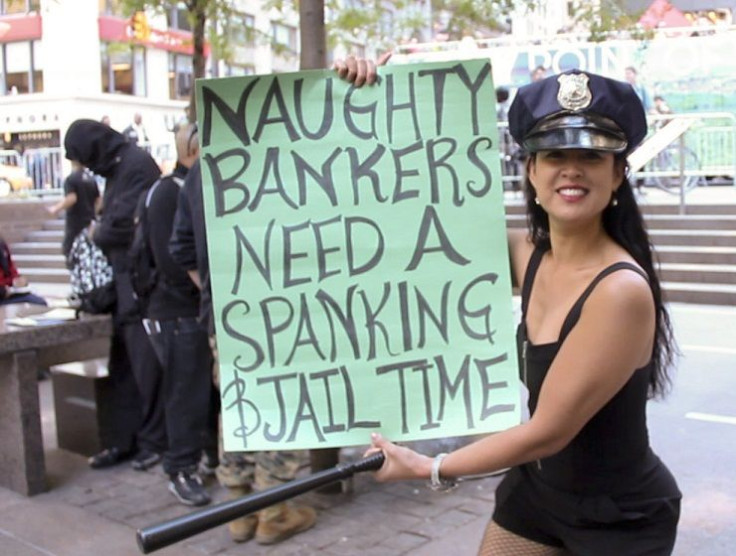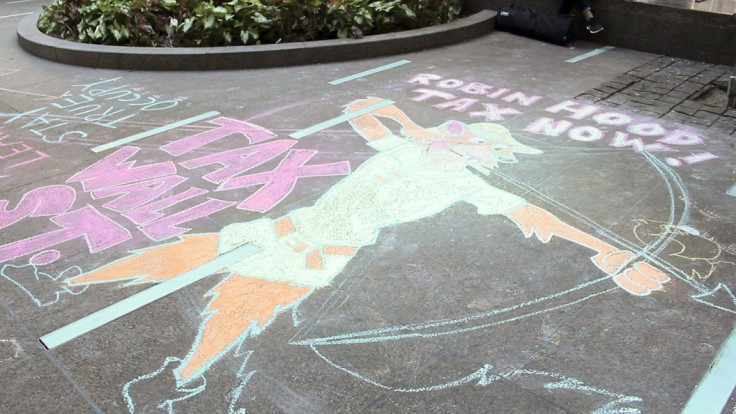Occupy Wall Street 2013: In Zuccotti Park, Frustration Over Lack Of Leadership, But Confidence That The Message Isn’t Dead

“We want people to understand that we’re not the extremists,” said Mike May, a 50-year-old Staten Islander armed with a shield of outspoken buttons and an armful of homemade protest signs. “We’re the messengers.”
May, along with hundreds of fellow demonstrators, arrived at Manhattan’s Zuccotti Park on Tuesday morning to mark the second anniversary of Occupy Wall Street, the scrappy, decentralized protest movement that sprouted up on Sept. 17, 2011, in the wake of rising income inequality, economic despair and capitalism run amok. It’s a movement that, for all its faults, never seemed to have much problem with basic branding, from its pervasive use of the mustached Guy Fawkes mask to its now-familiar “We Are the 99 Percent” catchphrase.
But scratch beneath the surface of those symbols and you’ll find a scattershot assortment of conflicting ideals, inconsistencies and vague messages. Two years after the first Occupy encampment spread from Lower Manhattan to cities around the world, it’s more apparent than ever that the movement -- or what’s left of it -- has sustained heavy damage amid a prolonged lack of organization and leadership. May, an Occupy veteran who spent three nights camped out in the park during its first year, admits that the movement’s loudest detractors, those who criticize its leaderless ethos as counterproductive, have a point.
“It’s a legitimate criticism,” he said. “Consensus can’t be reached because the issues can’t be framed in a way that brings together a majority of the people.”
The statement summed up an undercurrent of frustration that permeated demonstrations in Zuccotti Park this year. However enthusiastic attendees were for Occupy’s message of economic egalitarianism, they were equally critical of its enduring lack of cohesion.
“I wouldn’t give them an ‘A’ for organization, said Lillian Pollak, a lifelong radical and member of the group Raging Grannies, which works with Occupy. At 98, Pollak doesn’t fit the mold of the overeducated Millennial beating on drums and complaining of disenfranchisement, a stereotypical image of Occupy demonstrators that helped fuel criticism of the movement. She said she came to Zuccotti Park on Tuesday because she believes the message of income inequality still resonates, and she characterized the demonstrators as people whose “hearts are in the right place,” even if they do lack guidance.
“They’re idealistic young people, and it’s too bad that they couldn’t organize better,” she said.
Others seemed to feel downright uncomfortable with discussions of leadership. “That’s a bit of a touchy subject,” said Mark Hamilton, an artist who moved to New York City from Belfast, Northern Ireland, nine years ago.
Hamilton was sketching a chalk drawing in support of the Robin Hood tax -- a proposed tax on the financial sector -- when he spoke with International Business Times. He said the anti-hierarchical sensibility upon which the movement was founded is still very much alive at Occupy, even as he admitted that it might not be the most effective strategy.
“We’ve had to deal with all kinds of infiltration and disrupters, and organization has suffered because of that,” he said. “A lot of morale was lost. But people are still here. There is a core group of activists in New York who are still working on a lot of issues.”

But what about Occupy’s central issue, and what does the deteriorating state of the American middle class say about the movement’s success? Earlier this month a report by UC Berkeley’s Emmanuel Saez and the Paris School of Economics’ Thomas Piketty revealed that income inequality in the U.S. is at a record high. In other words, two years after Occupy first brought the issue into the national conversation, the top 1 percent are doing better than ever, while the rest of us continue to spiral closer and closer toward poverty.
Does that make Occupy a failure? Marni Halasa, a performance artist and figure skater who has been with the movement from the beginning, doesn’t think so.
“I feel like Occupy really put that [issue] on the map,” she said. “I think it’s also one of the reasons why Obama got [re]elected. Making that constant noise was really powerful, really compelling and really important.”
Halasa, an outgoing demonstrator who showed up at Zuccotti Park in revealing cop uniform-inspired attire and fishnet stockings, said she believes Occupy’s success can be measured in the ongoing community activism that continues to unfold under the Occupy banner. Sub-movement Occupy Sandy, for example, last year helped relief efforts for areas devastated by the hurricane that battered the East Coast.
As for whether Occupy Wall Street would benefit from a more conventional leadership structure, even some of its strongest supporters agree that it could. The problem is figuring out what form that might take. “Leadership means different things to different people,” said May. “We might have different opinions on what that is.”
Then he added with a smile: “But there’s nothing wrong with organization.”
© Copyright IBTimes 2024. All rights reserved.






















